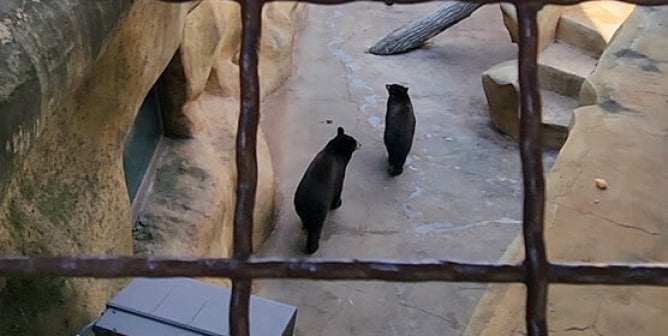Dogfighting: Dogs Tortured in Illegal Blood ‘Sport’
Dogfighting—a blood “sport” in which two dogs are pitted against each other in a fighting pit and forced to rip each other to shreds in a fight to the death for the “amusement” and monetary gain of spectator-gamblers—is illegal in the United States, and participating in dogfighting is considered to be a felony offense in every state.1
Forced to Fight and Left to Die
The most commonly bred dogs for fighting are Staffordshire terriers, American Staffordshire terriers, American bulldogs, and American pit bull terriers. All of them are usually referred to as pit bulls. Dogs are highly social pack animals who need and deserve love, attention, and exercise and thrive in an environment that offers the companionship of other dogs and human guardians. Dogs who are used for fighting are chained, taunted, and starved in order to trigger extreme survival instincts and encourage aggression.
Typically, before their first birthdays, puppies bred for fighting are placed in front of other dogs in order to test their aggression. At around 15 months, two prospective “fighters” are forced to participate in a “roll”—their first fight, which lasts about 10 minutes—followed by a second fight that lasts an hour. Survivors are chained again (sometimes with weighted logging chains) for a couple of months until they are ready for their first “show.” Breeders “train” dogs by forcing them to tread water in pools; run on a treadmill while a cat or another terrified animal, who may be someone’s stolen companion animal, is placed in a cage in front of the dog (to be caught and mauled to death as a reward afterward); and hang on with their jaws while dangling from a chain baited with meat.2,3 The dogs are likely injected with steroids, and some breeders go so far as to sharpen their dogs’ teeth, cut off their ears (in order to prevent another dog from latching on), and add roach poison to their food so that their fur might taste bad to other dogs.4,5
Dogs who do not fight or who lose fights are often used as “bait” animals, and sometimes, they are even abandoned, tortured, set on fire, electrocuted, shot, drowned, or beaten to death. Dogs who survive rarely make good companions, as breeders commonly mate close relatives in an effort to pass on the traits of dogs who are especially aggressive and whose instincts and training motivate them to kill other animals.
What Happens at Dogfights
Dogfights tend to be highly secretive, with location information spread by word of mouth or via the Internet. Participants might meet in one place and be taken en masse to another location so that even they don’t know where they’re going until they arrive.6 Abandoned houses, garages, warehouses, and fields all serve as sites for dogfights—places that can be quickly evacuated in advance of a raid.
A “pit” consists of a dirt or carpeted floor that is anywhere from 8 to 16 square feet and is surrounded by a wooden—and often portable—enclosure that is about 3 feet high. Dogs are taken to either end of the ring and released at the “face your dogs” command. Break or parting sticks are used to pry apart fighting dogs, who clamp down so fiercely that it is not uncommon for dogs to “fang” themselves (i.e., bite through their own lips).1 Fights can go on for hours—until one dog is seriously injured or dies.
Dogs are ranked by their “gameness”—the ability to keep fighting even when pain and loss of blood have caused them to go into shock.8 A federal prosecutor recalls a case in which one of 18 dogs found in a raid had 70 open wounds and was missing half a jaw while 75 percent of another dog’s body was covered with scar tissue.9 A Louisiana state police officer who conducts dogfighting investigations says, “When you go to where these fights have happened, you’ll find a couple of dog corpses or a pit full of blood.”10
The Tip of a Criminal Iceberg
Officials often stumble across dogfighting operations accidentally while searching property for other reasons. For instance, in 2007, authorities were searching Michael Vick’s property in rural Virginia for suspected drug activity when they discovered dogs who were tied to car axles with logging chains as well as dogfighting equipment, including treadmills, chains, whips, and injectable drugs.11
Dogfighting usually involves other crimes in addition to cruelty to animals. Gambling—which is frequently illegal and often involves large sums of money—takes place at many dogfights. Firearms and other weapons are also found and are sometimes used in violent crimes, including murder, as occurred at a Texas home when three intruders bound the wife and children of a well-known pit bull breeder and killed him for the $100,000 that he had won at a fight.12 When police responded to reports of dogfighting at a Phoenix residence, they arrested nine people and found drugs, guns, and a stolen car on the premises. Two injured dogs escaped from the house.13 A detective told the New York Daily News that “you can get more drugs and guns off the street by breaking up dog rings than you would breaking up drug rings.”14 An Ohio sheriff says, “Just about every dogfighting search warrant we’ve done, we’ve found drugs.”15
A review of Chicago dogfighting incidents over a three-year span found that in the nearly 400 cases, more than half the dog owners had gang affiliations and almost all had been arrested at least two times.16
What You Can Do
Federal law bans interstate commerce import and export of fighting dogs, and the penalty is three years in jail with a $250,000 fine.17 But as a Texas sheriff remarked, “If you don’t know it’s going on, there’s not a whole lot you can do. It’s organized crime.”18 One town in Michigan had such a problem with the illegal activity that it established a dedicated hotline for residents to report dogfights and animal abuse.19
Dogs raised for fighting are usually chained (or “tethered”), which is a safety hazard for the dogs and the community. A study published in Pediatrics magazine reported that “[b]iting dogs were significantly more likely … to be chained” and nearly three times as likely to attack than dogs who were not tethered.20 While many cities and counties have addressed this cruel and dangerous practice in an effort to prevent tragedy from striking near home, others consider such legislation only after an incident occurs in which a chained dog mauls a child in their area. For more information on how you can get your community to enact an ordinance that bans or at least restricts tethering, please visit HelpingAnimals.com.
If you suspect that dogfighting is happening in your neighborhood, contact local law-enforcement authorities.
References
1FoxNews.com, “Wyoming Becomes 50th State to Criminalize Dogfighting,” 5 Mar. 2008.
2Bill Burke, “Bloodsport: Dogfighting Once Had a Following Limited to the Rural South. but in the Age of the Internet, This Violent, Illegal Activity Has Seen a Cultural Shift,” The Virginian-Pilot 17 Jun. 2007.
3Julian Walker and Tom Campbell, “The Growth of Dogfighting,” The Richmond Times-Dispatch 3 Jul. 2007.
4Burke.
5Childs Walker, “Dogfight ‘Culture’ Reaches to Baltimore; Officials Link Bloody Pastime With Drugs, Gun Dealing, Gangs,” The Baltimore Sun 1 Jun. 2007.
6Renée C. Lee, “Dogfight Culture Thrives on Secrecy: Lack of Police Training Hinders Enforcement, Animal Welfare Experts Contend,” The Houston Chronicle 4 Sept. 2007.
7Drew Jubera, “Dogfighting: A Shadow World of Bloodlust,” The Atlanta Journal-Constitution 20 Jul. 2007.
8Associated Press, “Vick Case Illustrates Pit Bull’s Changing Status,” 24 Jul. 2007.
9Tom Weir, “Vick Case Sheds Light on Dark World of Dogfighting,” USA Today 18 Jul. 2007.
10Weir.
11Associated Press, “Feds Search Vick’s Property in Dog-Fighting Investigation,” 8 Jun. 2007.
12Lee.
13Patrick Lancaster, “Nine Arrested for Dog Fighting, Drugs,” ABC15.com 14 May 2012.
14Lisa Olson, “Dogfighting World Is Inhumane Society,” New York Daily News 19 Jul. 2007.
15Mark Gillispie, “Brutal Underground Sport Comes to Light; Secrets of the Dogfighting World Unleashed as Federal Officials Look at Case of NFL’s Vick,” The Plain Dealer 10 Jun. 2007.
16Walker.
17CNN.com, “Dogfighting a Booming Business, Experts Say,” 18 Jul. 2007.
18Lee.
19Ron Fonger, “Genesee County’s Dog Fighting, Animal Abuse Hotline Up and Running,” MLive.com, 15 May 2012.
20Kenneth A. Gershman et al., “Which Dogs Bite? A Case-Control Study of Risk Factors,” Pediatrics 93 (1994): 913–7.








